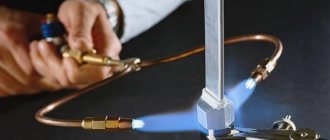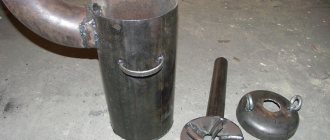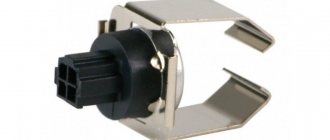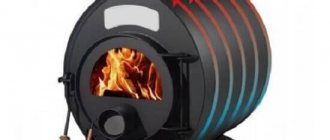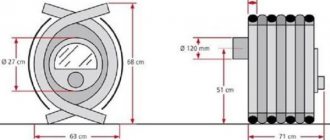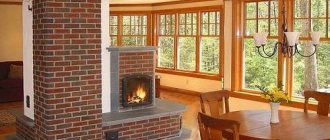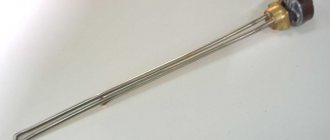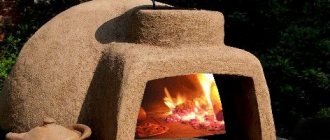Heating to high temperatures is a necessary component of many technologies that are used in home creativity, commercial activities and industrial production. Factory heating devices are highly efficient and, accordingly, have a price that not everyone can afford. A do-it-yourself muffle furnace for hardening metal can be assembled at minimal cost with excellent performance characteristics. To achieve the desired result, you should familiarize yourself with the device, operating principle and possible options for assembling a 1000 degree oven with your own hands.
What is a muffle furnace
A muffle furnace is a heating device designed to heat something to a given temperature.
A muffle furnace is a thermal device designed to heat materials to a given temperature. It consists of a heating chamber and a capsule (muffle) into which the object being processed is placed.
The scope of application of the devices is quite extensive:
- Laboratory analysis. The properties of many minerals appear at high temperatures.
- Blacksmith craft. Heating of workpieces while maintaining their shape and the absence of scale.
- Hardening of metal. Heat treatment changes the crystal structure, increasing strength and rigidity.
- Fuse. Isolation of the required substance from heterogeneous raw materials. This is how ingots of aluminum, gold and silver are obtained.
- Annealing. Helps achieve a given microstructure when creating parts from several components.
- Burning. Giving objects the necessary properties, such as hardness, presentability, resistance to moisture and chemicals.
- Heat treatment. Removing water, acid, oils, and other liquids from a substance to ensure complete drying.
- Vacation. Removing internal stresses after melting or hardening, achieving plasticity.
- Ashing. Removing foreign impurities by burning them. Determination of the presence of minerals in the alloy under study.
Using the functions of the devices allows you to obtain beautiful ceramics, souvenirs, and unique metal products.
Automation with temperature-time tasks
There are three types of automation for hardening furnaces. The cost of organizing furnace control increases along with the comfort of use. The simplest option is a simple thermostat with a thermocouple as a temperature sensor. This device will simply maintain the set temperature with a hysteresis of about 30–50 °C. The holding time is controlled manually, as is the moment the temperature point is reached.
More advanced automation is being developed specifically for electric ovens. Thermal controllers of the Autonics TCN4 type have a proportional power control function, providing adjustable hysteresis up to 1 °C. The device is also equipped with additional functions, such as an alarm when the set temperature is reached. If desired, the alarm channel can be used to activate a time delay relay installed in series with the thermostat.
The most advanced in this regard are automation devices for Profile-M type furnaces. They differ not only in built-in power relays, but also in the possibility of more flexible configuration. Such controllers have a preset timer, and also have the ability to configure heat treatment with a complex temperature profile, sequentially setting the duration of time periods during which a certain temperature should be maintained.
Types of muffle furnaces
Gas muffle furnace
Heating devices differ in several indicators, which does not particularly affect their performance characteristics.
Among specialists, a classification into certain categories is accepted.
Energy Source:
- electricity;
- natural gas;
- coking coal;
- firewood.
Content protection type:
- in the air (mechanical only);
- gas environment (argon, helium, nitrogen);
- vacuum.
Housing design (loading method):
- vertical;
- horizontal;
- detachable (bell-type).
Heating level:
- moderate;
- average;
- high;
- ultrahigh.
There is a gradation based on structural, refractory and electrically conductive materials used in the production of stoves.
Classification
Cameras can work on:
- Electricity.
- Gaza.
- Coal.
But it will not be possible to assemble a gas unit at home, since it is dangerous and prohibited by law. The coal version can only operate with supercharging. But if there is such a forge, then it is easier to place a muffle in it rather than build a special furnace. The electric option will allow you to control the heating temperature and use a compact unit even in an apartment (the power of such devices is about 2.5 - 4 kW, so a regular outlet with grounding and a reliable wire will do).
There are different forms of ovens:
- Horizontal.
- Vertical (potted).
- Tubular.
- Bell bells.
The first option is the easiest to reproduce on your own.
Muffle furnace design
For all their versatility, muffle furnaces have a relatively simple design. The peculiarity of the devices is the use of special components that can withstand temperatures up to 2000ºС.
The products consist of the following parts:
- Frame. The shape and size are determined by the volume of tasks assigned to the device. It is mandatory to install a valve to bleed gases released during the processing process. The body can be metal or made of modern polymers.
- A heating element. This could be a coal or wood stove, TEN, or gas burner.
- Internal lining. The walls are covered with ceramic plates, and in artisanal conditions with fireclay bricks.
- Door. There are various models, from the simplest ones with a handle to modern ones, which use a lever system that eliminates contact with hot parts.
- Communications. Depending on the type of product, this is a power cable, a high-pressure cylinder and hose, or a mechanical blower.
- Muffle. Chemical ceramic capsule of stationary or replaceable type.
- Controls. The devices can be equipped with a light and sound alarm, an interface for communication with a computer, a recording device, and a thermostat-programmer.
Depending on the production cycle, the furnaces are turned on for a certain period of time or operate continuously with periodic replacement of filled muffles.
Refractory masonry
We buy fireclay bricks at the construction market. This brick is intended for laying furnaces of stoves and fireplaces. This brick is able to withstand prolonged exposure to heat at a temperature of 1000 degrees and repeated cycles of cooling and heating, has a high heat capacity and thermal inertia. As a binder, it is best to buy a special fireproof dry mixture for laying fireclay.
Fitting and marking
Types and conditions of processing of raw materials
Muffle furnace for hardening metal
In the process of processing workpieces, various processing methods can be used in terms of time and degree of heating, duration and cooling methods. One or another method of protecting workpieces can also be used.
The material processing technology used is as follows:
- Ceramics. Open, 600ºС.
- Porcelain. Open, 800ºС.
- Faience. Open, 1000ºС.
- Majolica. Open, 1200ºС.
- Hardening of cutting metal products. Argon 800ºС.
- Melting of non-ferrous metals. Argon 800-1200ºС.
Deviation from the instructions leads to deterioration in the quality of the finished product or damage to the loaded substance.
Areas of application
The layout used must allow the required amount of material to be placed for processing.
It is worth dividing all furnaces into types of application for working with the material:
- hardening of metal and Kremlin products;
- firing and bringing the material to a certain structure, imparting strength;
- tempering, imparting plasticity to the material to make the corresponding products;
- blacksmithing, for splitting metal for subsequent processing and creating more acceptable sizes and workpieces;
- laboratory studies to study the effect of temperature treatment on metals and alloys of various formulas.
This division allows you to determine the types of temperature conditions and the total volume of the furnace, creating all the necessary design solutions and formulas for independent design of a muffle furnace.
Making a homemade muffle furnace
To make a stove you will need a grinder. A
do-it-yourself muffle furnace is made using the following tools:
- screwdriver;
- roulette;
- hammer;
- level;
- soldering iron;
- pliers;
- Bulgarian;
- electric drill.
After preparing the necessary equipment, you need to make a drawing and, based on it, start preparing the components.
For a homemade housing, you can use faulty or old household appliances that have been idle for a long time - a microwave, oven, freezer. All fillers that can melt and burn under high heat must be removed from the casing. If there are no such objects at hand, the body is made independently. To do this, a steel sheet with a thickness of at least 2 mm is taken and welded into a rectangular or round structure. It is advisable to use a gas cylinder or a steel pipe with thick walls as a ready-made template. To protect against corrosion and give the product a presentable appearance, it must be coated with fire-resistant paint.
The stove is made from fireclay clay mixed with sand and asbestos
Another way to make a stove is to model it from a mixture of fireclay clay, sand and fluffed asbestos. A wax mold is first made, on which protrusions for the legs are made. A mixture of plasticine consistency is evenly distributed over the pattern, then dried at room temperature for two weeks. Then the wax is melted with a hairdryer, and the mold is calcined in coals for 6 hours.
If there is a transformer substation nearby, the task is greatly simplified. There, for a reasonable fee or for nothing, you can get tubes from fuse links. The products are made of a durable substance and are designed to withstand extreme heat and temperature changes. All that remains for the master is to work a little with a grinder and fireclay clay.
The next item will be the installation of the heating element and thermostat (control unit sensors). Two gas burners or electrical elements are mounted on the furnace body. The burners are installed from below and from above. Electric heaters are fixed depending on their configuration. The wire is wound in a spiral, TENs are placed on the sides, and if heat of 1500ºC or higher is needed, then on the floor and vault. Ground must be provided to prevent electric shock to the employee. The heaters are then covered with a steel casing, in which a hole is made for the air valve.
Thermal insulation is applied to the outer casing as tightly as possible to its surface. The best option today is considered to be basalt wool in rolls. To close the camera securely enough, a layer 20 mm thick is enough. The thermal insulation can be secured with aluminum tape or copper wire wound in frequent turns. The finished structure is placed in the housing if such a stove model is selected.
The penultimate step before installing the electronics is making the cover.
Process sequence:
- Fitting, fastening and adjusting hinges. Screw or wedge locking devices are used.
- Fireclay bricks are taken and cut to size. The edges are ground down to ensure the lid closes.
- A solution is prepared from clay, sand and cement in a ratio of 1:3:1. It is applied to the door, the brick is pressed tightly, and pressure is placed on top.
- After drying, the cover is hung in place and the joints are sealed. Heat-resistant silicone is used, applied around the perimeter of the sash.
You can use the device after 2-3 hours.
The simplest option for arranging a muffle furnace for firing ceramics is a combination of a powerful electric stove and medical ceramics. Fireclay should be placed under the vessel to ensure even distribution of heat. The power is regulated by the standard tile device.
Principle of operation
Furnaces for firing ceramic products, regardless of the type of fuel, operate according to a certain scheme:
- air-dried clay products are placed in the cavity for placement. We place large items at the bottom and place the rest of the toys or plates like a pyramid;
- The oven door closes tightly and the temperature in the oven gradually increases. First we bring it to 1500-2000;
- after preliminary heating of the parts for 2 hours, the temperature rises to 3500-4000;
- after 2 hours we increase the temperature by another 2000 and so bring the heating to 9000;
- turn off the heating devices or extinguish the flame in the oven and leave the products to cool gradually. The door must always be closed until the finished ceramic is removed.
Uniform and gradual cooling makes ceramics strong and durable. After the entire firing stage, you can begin to apply a layer of glaze or other decorative finishing.
Important! Using an oven for baking polymer clay, we achieve volume of products and give them additional attractiveness. A flower bouquet that has been hardened will look like a real one.
Safety precautions
The handles are made of dielectric plastic.
The muffle furnace is a potentially dangerous device that requires compliance with the following safety measures:
- the turns should not touch each other, otherwise a short circuit will occur;
- for putty you can use clay or heat-resistant silicone;
- handles must be made of dielectric plastic.
When working with the stove, you must use effective ventilation.
Operating rules
The electric oven may only be plugged into a reinforced socket. You can also run a large cross-section wire directly from the shield. In addition, it would be useful to install a circuit breaker.
Since this device model has exposed wires, you need to be extremely careful with it. Do not touch the coils while the oven is running. To avoid accidents, it is recommended to install a limit switch on the door, which will turn off the unit when the door is opened. If you are not very good at electrical work, seek the help of a specialist who can help make the device as safe as possible, including grounding it.
Useful video
Watch the video, which shows how to start making a muffle furnace: what materials and tools are required, what needs to be done first, and what actions are not recommended.
1ba8d3678997cd1220be3ef58cf59f99.jpe ce84308707c136bdb783c4f4656f6cf0.jpe
Making the lid
- Cut a circle out of steel, identical in diameter to the already fully assembled structure.
- Place fireclay bricks on top of the glue - it will provide sufficient sealing.
Weld handles on the sides to make it convenient to lift and remove the lid, and a latch for closing.
Cover the edges with fireproof silicone; before doing this, be sure to degrease the surface (even White Spirit will do).
Let us remind you that when the oven is operating, it must be closed. Excessive air ingress will lead to rapid wear of nichrome.
What should the ventilation be like?
In reality, manufacturing, or rather the process of firing ceramics itself, is not so beneficial to health. And then many can conclude that the stove has no place in the house at all. There should be a special closet for her. Many people think even longer that they pollute the air a lot and so on and so forth. But compared to other indicators of pollution, the emissions from such a stove are simply nothing to the air.
But for those who dared and brought the stove into the house. What kind of ventilation should there be so as not to cause harm. So, the room must be well ventilated, since the firing time is many hours and during this time there is a constant release of substances that are harmful to health. Ventilation options for a room with a stove for firing ceramics:
- several open windows will help make air move and remove all odors and harmful particles immediately from the window;
- a special design of the ventilation system (a hole with a fan in the wall itself, through which air from the street will be taken into the room and emissions from the stove will be removed);
- Downdraft system and Updraft are special ventilation systems that craftsmen have thought out specifically for rooms where kiln firing takes place.
Here are many ways to help your hands not give up your favorite activity, and your health not to suffer from the harmful release of substances during firing.
Heating the muffle with gas
A homemade muffle furnace can operate not only from electricity, but also under the influence of a gas burner. You can purchase such a heating element or make it yourself.
To create a gas burner, you need a metal pipe 10-15 centimeters long. The diameter of the pipe should not exceed a few centimeters. First, you should make a through hole near the edge for connecting the gas tube. It is also necessary to make several one-sided holes perpendicular to it. They are necessary to ignite the device.
For a gas burner you will need a metal pipe 10-15 centimeters long
The gas tube is made of copper, its diameter does not exceed 0.8 centimeters. Threads are required at both ends of the tube. In the middle of the device you need to make a small blind hole for the gas to escape. One hole must be closed with a plug, and a gas cylinder must be connected to the other. When combining elements of the device, be sure to install a valve between the hose and the burner, as it will protect the structure from fire.
